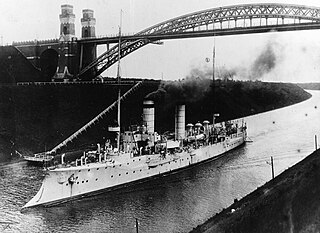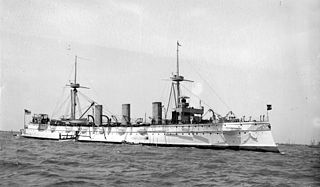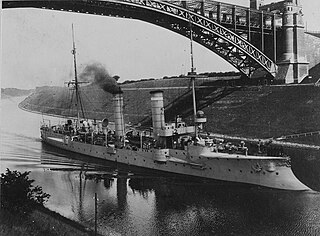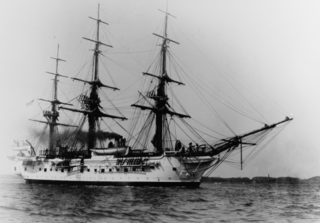
SMS Seeadler was an unprotected cruiser of the Bussard class, the third member of a class of six ships built by the German Kaiserliche Marine. Her sister ships included Bussard, the lead ship, along with Falke, Condor, Cormoran, and Geier. Seeadler was built at the Kaiserliche Werft in Danzig in late 1890, launched in February 1892, and commissioned in August of that year. Intended for colonial service, Seeadler was armed with a main battery of eight 10.5-centimeter (4.1 in) guns and had a top speed of 15.5 knots.

SMS Arcona was the ninth member of the ten-ship Gazelle class of light cruisers that were built for the German Kaiserliche Marine in the late 1890s and early 1900s. The Gazelle class was the culmination of earlier unprotected cruiser and aviso designs, combining the best aspects of both types in what became the progenitor of all future light cruisers of the Imperial fleet. Built to be able to serve with the main German fleet and as a colonial cruiser, she was armed with a battery of ten 10.5 cm (4.1 in) guns and a top speed of 21.5 knots. Arcona was a modified version of the basic Gazelle design, with improved armor and additional coal storage for a longer cruising range.

The Brandenburg class consisted of four pre-dreadnought battleships built for the German Kaiserliche Marine, the first modern battleships of the fleet. The four ships of the class—Brandenburg, Wörth, Weissenburg, and Kurfürst Friedrich Wilhelm—were the first ocean-going capital ships built for the German fleet in nearly two decades, owing to reluctance in the Reichstag to fund large projects. They followed a series of small coastal defense ships, and though in retrospect they anticipated the buildup that created the High Seas Fleet, they were ordered as part of a construction program that reflected the strategic and tactical confusion that affected many navies in the 1880s. The design process that resulted in the Brandenburg class was very lengthy, with proposals that ranged from outdated casemate ships to versions with two twin-gun turrets placed side by side. The designers ultimately settled on ships that were armed with an unusual main battery of six 28 cm (11 in) guns at a time when all foreign battleships were built with four or fewer heavy guns.

SMS Kaiserin Augusta was a unique protected cruiser, built for the German Kaiserliche Marine in the early 1890s. Named for Empress Augusta, who died in January 1890, she was laid down in 1890, launched in January 1892, and completed in November of that year. Owing to budgetary restrictions, Kaiserin Augusta was designed to fill both fleet scout and colonial cruiser roles. The ship was initially armed with a main battery of four 15 cm (5.9 in) and eight 10.5 cm (4.1 in) guns, which by 1896 was replaced with twelve new model 15 cm guns. She was the first ship in the German Navy to feature a three-shaft propeller arrangement.

SMS Medusa was a member of the ten-ship Gazelle class of light cruisers that were built for the German Kaiserliche Marine in the late 1890s and early 1900s. The Gazelle class was the culmination of earlier unprotected cruiser and aviso designs, combining the best aspects of both types in what became the progenitor of all future light cruisers of the Imperial fleet. Built to be able to serve with the main German fleet and as a colonial cruiser, she was armed with a battery of ten 10.5 cm (4.1 in) guns and a top speed of 21.5 knots. Medusa served in all three German navies—the Kaiserliche Marine, the Reichsmarine of Weimar Germany, and the Kriegsmarine of Nazi Germany—over the span of over forty years.

The Irene class was a class of protected cruisers built by the Imperial German Navy in the late 1880s. The class comprised two ships, Irene and Prinzess Wilhelm; they were the first protected cruisers built by the German Navy. As built, the ships were armed with a main battery of fourteen 15 cm (5.9 in) guns and had a top speed of 18 knots. They were modernized in 1899–1905, and their armament was upgraded with new, quick-firing guns.

The Bismarck-class corvettes were a class of six corvettes built for the German Kaiserliche Marine in the 1870s. The six ships were Bismarck, Blücher, Stosch, Moltke, Gneisenau, and Stein. The Bismarck-class corvettes were ordered as part of a major naval construction program in the early 1870s, and they were designed to serve as fleet scouts and on extended tours in Germany's colonial empire. The ships were armed with a battery of between ten and sixteen 15 cm (5.9 in) guns and they had a full ship rig to supplement their steam engine on long cruises abroad. One ship, Blücher, was converted into a torpedo testing and training ship shortly after she was completed, having her guns replaced with a variety of torpedo launchers.

SMS Bussard was an unprotected cruiser of the Imperial German Navy, built in the 1880s. She was the lead ship of her class, which included five other vessels. The cruiser's keel was laid in 1888, and she was launched in January 1890 and commissioned in October of that year. Intended for overseas duty, Bussard was armed with a main battery of eight 10.5-centimeter (4.1 in) guns, and could steam at a speed of 15.5 knots.

SMS Falke was an unprotected cruiser of the Bussard class, built for the Imperial German Navy. She was the second member of the class of six vessels. The cruiser was laid down in 1890, launched in April 1891, and commissioned into the fleet in September of that month. Designed for overseas service, she carried a main battery of eight 10.5-centimeter (4.1 in) guns and had a top speed of 15.5 knots.

SMS Condor was an unprotected cruiser of the Imperial German Navy. She was the fourth member of the Bussard class, which included five other vessels. The cruiser's keel was laid down in Hamburg in 1891, she was launched in February 1892, and was commissioned in December of that year. Intended for overseas duty, Condor was armed with a main battery of eight 10.5-centimeter (4.1 in) guns, and could steam at a speed of 15.5 knots.

SMS Cormoran was an unprotected cruiser of the Bussard class, the fifth member of a class of six ships. She was built for the Imperial German Navy for overseas duty. The cruiser's keel was laid down in Danzig in 1890; she was launched in May 1892 and commissioned in July 1893. Cormoran was armed with a main battery of eight 10.5-centimeter (4.1 in) guns, and could steam at a speed of 15.5 knots.

SMS Schwalbe was an unprotected cruiser built for the German Kaiserliche Marine, the lead ship of the Schwalbe class. She had one sister ship, Sperber. Schwalbe was built at the Kaiserliche Werft in Wilhelmshaven; her keel was laid down in April 1886 and her completed hull was launched in August 1887. She was commissioned for service in May 1888. Designed for colonial service, Schwalbe was armed with a main battery of eight 10.5-centimeter (4.1 in) guns and had a cruising radius of over 3,000 nautical miles ; she also had an auxiliary sailing rig to supplement her steam engines.

SMS Sperber was an unprotected cruiser built for the German Kaiserliche Marine, the second member of the Schwalbe class. She had one sister ship, Schwalbe. Sperber was built at the Kaiserliche Werft in Danzig; her keel was laid down in September 1887 and her completed hull was launched in August 1888. She was commissioned for service in April 1889. Designed for colonial service, Sperber was armed with a main battery of eight 10.5-centimeter (4.1 in) guns and had a cruising radius of over 3,000 nautical miles ; she also had an auxiliary sailing rig to supplement her steam engines.

The Bussard class of unprotected cruisers were built for the German Kaiserliche Marine in the late 1880s and early 1890s. The class comprised six ships: Bussard, the lead ship, Falke, Seeadler, Cormoran, Condor, and Geier. Designed for service in Germany's colonial empire, the class emphasized a long-range cruising radius and relatively heavy armament; they were also the last cruisers in the Kaiserliche Marine to be equipped with an auxiliary sailing rig. The ships were equipped with eight 10.5-centimeter (4.1 in) guns.

SMS Charlotte was a German screw corvette built for the Kaiserliche Marine in the 1880s, being laid down in April 1883, launched in September 1885, and commissioned in November 1886. The only vessel of her class, Charlotte was the last sailing warship built for the German navy. She was armed with a battery of eighteen 15 cm (5.9 in) guns.

SMS Carola was the lead ship of the Carola class of steam corvettes built for the German Kaiserliche Marine in the 1880s. Intended for service in the German colonial empire, the ship was designed with a combination of steam and sail power for extended range, and was equipped with a battery of ten 15-centimeter (5.9 in) guns. Carola was laid down at the AG Vulcan shipyard in Stettin in 1879, launched in November 1880, and completed in September 1881.

SMS Alexandrine was a member of the Carola class of steam corvettes built for the German Kaiserliche Marine in the 1880s. Intended for service in the German colonial empire, the ship was designed with a combination of steam and sail power for extended range, and was equipped with a battery of ten 15-centimeter (5.9 in) guns. Alexandrine was laid down at the Kaiserliche Werft in Kiel in 1882, she was launched in February 1885, and she was completed in October 1886 before being laid up after completing sea trials.

The Carola class was a group of six screw corvettes built by the German Kaiserliche Marine in the late 1870s and 1880s. The class comprised Carola, the lead ship, Olga, Marie, Sophie, Alexandrine, and Arcona. They were ordered to replace older sailing vessels that were no longer sufficient to protect German interests around the world. Intended for service in the German colonial empire, the ships were designed with a combination of steam and sail power for extended cruising range, and they were equipped with a battery of ten 15-centimeter (5.9 in) guns. Relying primarily on sail power for their long-range deployments, the ships were obsolescent before construction began.

SMS Nixe was a screw corvette built for the German Kaiserliche Marine in the 1880s. She was laid down in August 1883, launched in July 1885, and commissioned into the fleet in April 1886. Hopelessly out of date even by the time she was ordered in 1882 and possessing insufficient gun power or speed, she was nevertheless completed as designed. In addition to those shortcomings, she proved to be difficult to handle in service and was particularly affected by wind.



















